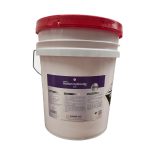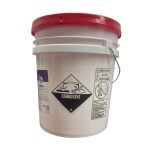Sodium hydroxide is a highly caustic base and alkali that decomposes proteins at ordinary ambient temperatures and may cause severe chemical burns. It is highly soluble in water, and readily absorbs moisture and carbon dioxide from the air. It forms a series of hydrates NaOH·nH2O.[11] The monohydrate NaOH·H2O crystallizes from water solutions between 12.3 and 61.8 °C. The commercially available “sodium hydroxide” is often this monohydrate, and published data may refer to it instead of the anhydrous compound.
Uses of Sodium Hydroxide- NaOH
- Used in the manufacturing of detergents and soaps
- Used in the production of bleach-like chlorine
- Used in drain cleaners
- Used in the removal of heavy metals from the water by the municipal water treatment facility
- Used in food preservatives to prevent bacteria and mold growth
- Used for canning
- Used in papermaking and paper recycling process.
- Used in chemical manufacturing, petroleum refining, cleaning compounds, drain cleaners.
- Used in industrial and consumer products in large quantities. Because of the alkaline properties, high concentrations of sodium hydroxide are corrosive
- It is also used in processing cotton fabric, laundering and bleaching, metal cleaning and processing, oxide coating, electroplating, and electrolytic extracting
Disclaimer : Any of above statements have not been evaluated by the food and drug administration (FDA).This product is not intended to diagnose, treat, cure, or prevent disease. This information provided is general and should not be taken as medical advice. This product is for research use only.We strongly advise you to have a test batch before use. If you suffer any adverse reactions or symptoms, please discontinue use immediately.
THIS PRODUCT CAN BE SHIPPED ON GROUND ONLY. DAWN SCI RESERVE THE RIGHT TO CANCEL YOUR ORDER IF ANY SHIPMENT REQUIRES AIR SHIPMENT. THANK YOU FOR YOUR UNDERSTANDING
What is the sodium hydroxide solution used for?
Sodium hydroxide is used in the manufacture of soaps and a range of detergents used in homes and business applications. Combining chlorine and sodium hydroxide, chlorine bleach is made.
What is the importance of sodium hydroxide?
A metallic caustic base is sodium hydroxide (Na OH), also known as lye or caustic soda. An alkali, caustic soda is commonly used in many industries, mostly in the manufacture of pulp and paper, textiles, drinking water, and detergents as a strong chemical base.
Is sodium hydroxide soluble in ethanol?
Pure sodium hydroxide is a colourless crystalline solid which melts without decomposition at 318 ° C (604 ° F) and boils at 1,388 ° C (2,530 ° F). Despite lower solubility in polar solvents such as ethanol and methanol, it is highly soluble in water.
Why is sodium hydroxide used in soap?
It is not used for shaving, It is used for soap production. Oil and fat triglycerides react with sodium hydroxide to form fatty acid glycerol and sodium salts, the latter being the soaps. The extraction of excess sodium hydroxide is done with great caution because it is very caustic.
What are other names or identifying information for sodium hydroxide?
CAS Registry No.: 1310-73-2
Other Names: Caustic soda, Lye
Main Uses: Manufacture of other chemicals and used in many manufacturing processes.
Appearance: Colourless – white solid.
Odour: Odourless
What are the most important things to know about sodium hydroxide in an emergency?
Emergency Overview: Colourless – white solid. Odorless. Highly Reactive. Incompatible with many common chemicals. Reacts violently with water. Contact with metals liberates flammable hydrogen gas. EXTREMELY CORROSIVE. Causes severe skin burns and eye damage.
What handling and storage practices should be used when working with sodium hydroxide?
Handling: Before handling, it is important that all engineering controls are operating and that protective equipment requirements and personal hygiene measures are being followed. Only trained personnel should work with this product. Immediately report leaks, spills or failures of the safety equipment (e.g. ventilation system). Avoid generating vapors or mists. Avoid generating dusts. Use corrosion-resistant tools and equipment. Never add water to a corrosive. Always add corrosives slowly to COLD water. Never reuse empty containers, even if they appear to be clean. Keep containers tightly closed when not in use or empty.
What handling and storage practices should be used when working with sodium hydroxide?
Handling: Before handling, it is important that all engineering controls are operating and that protective equipment requirements and personal hygiene measures are being followed. Only trained personnel should work with this product. Immediately report leaks, spills or failures of the safety equipment (e.g. ventilation system). Avoid generating vapors or mists. Avoid generating dusts. Use corrosion-resistant tools and equipment. Never add water to a corrosive. Always add corrosives slowly to COLD water. Never reuse empty containers, even if they appear to be clean. Keep containers tightly closed when not in use or empty.
Storage: Store in an area that is: cool, dry, well-ventilated, separate from incompatible materials. Keep the amount in storage to a minimum. Store in the original, labelled, shipping container. Vent drums to prevent pressure buildup. Do not handle swollen drums. Get expert advice. Empty containers may contain hazardous residue. Store separately. Keep closed. Contain spills or leaks by storing containers in trays made from compatible materials.



































Reviews
There are no reviews yet.